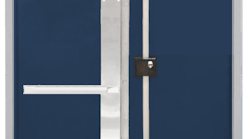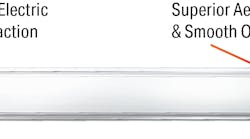Door Safety, LLC, is in the final phase of transitioning into the Safe Doors Saves Lives Foundation, Inc (SDSLF), a Virginia-based non-stock (aka non-profit) educational company founded by Keith E. Pardoe, DSC, DSI, FDAI, DAHC, CDC, CDT, whose career in the swinging door industry spans more than 38 years. In 2017, Pardoe founded Door Safety, LLC, to provide training and information to end users regarding inspecting and maintaining swinging egress and fire doors.
“We are in the process of obtaining our 501(c)(3) status from the Internal Revenue Service,” says Pardoe. “IRS Pub 557 indicates that the effective date of our exemption will be retroactive to our date of incorporation which is May 5, 2023.”
Training and Education
Providing the necessary training and resources for security professionals is the overriding goal of the foundation. Pardoe has dedicated his life to this area and is a Principal member and current Chair of NFPA's Fire Door and Window (FDW-AAA) technical committee. He is also a Principal member of NFPA's Fire Protection Features technical committee (BLD-FIR/NFPA 5000 and SAF-FIR/NFPA 101), and a member of the American Society for Health Care Engineering's ASHE Faculty team. Pardoe joined the staff of the Door and Hardware Institute (DHI) in 1996, where he was the Director of Education & Certification, a position he held for most of his time at DHI. He retired from DHI in 2014 and started Pardoe Consulting, LLC, although he continues to be an instructor for DHI Canada.
The new foundation will offer the Online Door Safety Inspector (DSI) Training & Certification Class, which is instructed by Pardoe and offered two times per year.
“Fire doors are specially engineered fire protective systems that have one job — preventing a fire from spreading; they must be kept in a constant state of readiness,” he asserts. “Individuals performing NFPA 80’s door safety inspections need to have a working knowledge of the fire doors they inspect, as well as the code requirements affecting them. Door Safety Inspectors (DSI) exceed NFPA’s Qualified Person standard (for NFPA 80 and NFPA 105) and NFPA 101’s Knowledgeable Person standard for inspecting and testing egress and fire door assemblies.”
In addition to covering the myriad code provisions and requirements for swinging egress and fire doors, this course teaches “The How” of performing door safety inspections, especially when you are inspecting older existing doors (e.g., doors more than 25 years old).
This online live instructor-led course consists of approximately 40 hours of instruction over six weeks, with another 12 to 16 hours to complete the reading and homework assignments. Recordings of each session are published on the course site on Door Safety’s LMS to access anytime. To complete the class, students must pass the four-hour DSI Certification exam with a minimum score of. 80 percent. Students can take the online live proctored exam from their home or office computers at their convenience.
Pardoe points out that for the class students receive several key resources, including the Door Safety’s A Constant State of Readiness: Inspecting and Maintaining Swinging Doors Handbook (First edition); NPFA 80, Standard for Fire Doors and Other Opening Protectives (2016 edition); NFPA 101, Life Safety Code, (2015) edition; NFPA 105, Standard for Smoke Door Assemblies and Other Opening Protectives (2016 edition); DSI Training & Certification Class Workbook; A DoorGapGauge.
By the end of this course, students will be able to:
· Look up and explain door-related requirements in NFPA 80, NFPA 101, and NFPA 105.
· Describe how codes and standards apply to existing and older existing construction (e.g., egress and fire doors).
· Correctly apply inspection and testing requirements to new, existing, and older existing doors.
· Discuss the evolution of swinging fire doors over the past 75 years.
· Explain door usage types and categories and door maintenance priority levels.
· Recommend code-compliant repairs for fire-rated doors.
· Assist facilities in their ongoing door maintenance programs.
· Explain when field labeling of door frames, doors, and hardware components might be appropriate—and when it’s not.
· Perform Acceptance Testing inspections.
· Perform door safety inspections of swinging egress and fire-rated door assemblies.
While it has been offered as an in-person five-day class, the online course seems to work best because it's broken up into a six-week period, notes Pardoe. “We meet twice a week, Tuesdays, and Thursdays, for about 3 hours each meeting, so we're still getting through those 40 hours of content, but it's spread out and it gives it gives the students time to kind of digest it and do the reading assignments, do the exercises and gives us a little bit more time to review things,” he explains. “And it seems to have a very high success rate when it comes to when they finally come to take the exam – above 80% or so, which is what I like.”
Another challenge with the face-to-face class, he adds, “You run through five days of class and then you jump into a four-hour exam and they're just tired. Their brains are mushed by that point, and you know they really haven't had time to learn or retain what we what we talked about on Monday.”
Another advantage of the online class, he points out, is that everything is recorded and then it's posted then posted where they can go back and replay any portion that they want.
“The other thing that I do I one of my if you could see my computer system, I've got four monitors and the monitor off to my left is a very special one that allows me to draw on the screen and add notes and whatnot. A lot of the class is PowerPoint, but most of the class I actually have a PDF of the code and standards up on the screen and I'll take them through them and I'll tell them, you know, make a note here and I show them how things are linked together because learning how to use the books is a whole new skill that most of these people have never had. They've never had to learn, and you know, code books are their books, but they don't tell a story.”
Opportunity for Locksmiths
Pardoe points out that door inspections are a natural extension of what locksmiths are already doing
“I think it's a natural fit for the institutional locksmiths and anybody else that has hands on doors. NFPA 101, the latest safety code, there are certain doors that need to be inspected that are non-fire rated torsion, and that means it needs to be egress. And the institutional locksmiths they are hands-on, and they are on the front line, so they can be that trusted resource.”
Locksmiths and other security professionals on that front line, as Pardoe points out, have additional responsibility to make sure that any work on the door has been done properly.
“They need to know that someone like me is going to look at that door at some point in time and follow their work,” Pardoe points out. “So that door needs to be properly installed and adjusted and maintained. Or, you know, as we discussed, they could be the inspectors doing the work … it's a natural extension of what they're already doing there. There's no reason why they shouldn't do this work.”
When asked what advice he would give to young security professionals, he says, "Take the time to learn everything you can about egress and fire doors, especially the provisions and requirements of the building, fire, and life safety codes — past and present — and the standards that affect them. Remember, fire doors have one job, preventing a fire from spreading! Egress doors must allow us to evacuate safely under fire and other panic-inducing conditions. Accordingly, our codes (past and present) require egress and fire doors to be kept in a Constant State of Readiness. Mastering the codes and standards affecting egress and fire doors will help you have a long and rewarding career. What we do matters.”
For more information on the foundation, please visit www.doorsafety.com.





